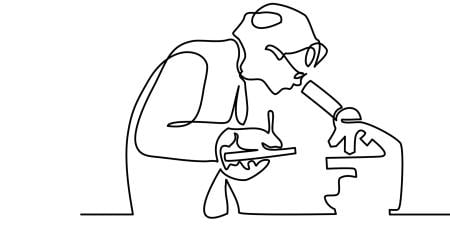Case
Susan is a member of an institutional review board (IRB) at an academic institution in a large city. A phase 3 protocol is up for its annual review. The multi-center study, sponsored by a large pharmaceutical company, is designed to assess the safety of a new medication for the treatment of asthma. This is one of the soundest protocols Susan has come across during her time on the IRB: the aims are well-defined, the study design is scientifically valid, the informed consent form is clear, the risks-to-benefit ratio is good, and no adverse events have been reported to date. The study entails three full-day sessions, and the risk involved is classified as greater than minimal due to blood draws necessary to study the pharmacokinetics of the drug. Participants are paid $25 for the initial screening visit with a physician and $75 for each subsequent day-long session, for a total compensation of $250 to those who complete the entire study.
After the first round of recruitment, Susan notices that the majority of the participants are of a lower socioeconomic status (SES). This trend continues during the second round of recruitment. Susan becomes even more concerned when a colleague mentions that some of the study participants are homeless. When she mentions her concern to the full IRB committee, one of her colleagues remarks that studies have shown that the highest prevalence of asthma is associated with the lowest socioeconomic status, so it is appropriate, indeed ethical, for many people from this group to incur the research risks; they stand to benefit most from it.
Troubled by this answer, Susan wonders whether the monetary compensation for the study exerts an undue influence on those who would otherwise not consent to participate in it. Given the demographics of the city, with a large socioeconomically vulnerable population, she wonders whether the participants are being paid too much.
During a conference call with a colleague at another urban study site, Susan is alarmed to hear that participants are being compensated twice as much, all other things being equal. What if the participants at her institution are being paid too little for their time? How can the IRB pay participants enough to compensate them for exposure to the study risks without paying them so much that the payment constitutes undue inducement? Susan also wonders whether there are merits to a sliding scale of payment that depends on the socioeconomic status of the participants and whether this practice is ethically justifiable.
Commentary
Payment for participation in research makes many IRB members nervous because of their concerns about why we pay study participants and whether it could lead to harm [1, 2]. Coercion in this context is best described as a person’s being forced into a decision that might leave him or her in a worse position than if he or she never encountered the offer. Luckily, due to stringent regulatory guidelines, coercion, strictly understood, does not often occur in clinical research because people are technically able to choose not to participate [3]. Undue influence, however, is more complicated; it occurs when the compensation or incentive is sufficient to induce prospective participants who otherwise would not enroll to enter studies in which there might be significant risks. The worry is that people with limited resources are more susceptible to inducements to act against their own best interests, or that, worse, they could be targeted for recruitment because they are easier to influence with smaller sums of money.
There are many interpretations of what constitutes undue influence. According to Ruth Macklin, an inducement is undue if it encourages participants to lie or conceal information in order to participate or prompts participants who otherwise would not participate to enter a study that poses significant risks [4]. She also argues that an inducement may be undue if participants could have been recruited for less compensation [4]. Similarly, Neal Dickert and Christine Grady argue that undue inducement occurs when an incentive is so attractive that it causes people to ignore their personal values or preferences in order to participate in the research [5]. Yet another definition of undue inducement, described by Ezekiel Emanuel, includes four elements: (1) an offered good (2) of excessive value, making it extremely compelling, (3) which encourages participants to exercise poor judgment (4) while taking on risk of serious harm [6].
From the information presented in the case scenario, the phase 3 clinical trial for asthma medication has been thoroughly reviewed and approved by the IRB at Susan’s institution. Most importantly, the risks-to-benefit ratio has been determined to be good and no adverse events have been reported, suggesting that those enrolled in the trials are not exposed to serious or significant harm.
Is undue influence a potential problem in this case? It is important to note that when an IRB is determining the safety of a clinical trial, the research is judged independently of payment or incentive to try to get an accurate assessment of the true benefits and risks of the study. The main risk cited in this case scenario is necessary blood draws, which are generally not considered extremely risky. If we accept that the harm-to-benefit ratio of the study is good, then no one would be considered to have been unduly influenced, since it would be reasonable to expect that none will experience more harm than benefit from participation. Without this key component of serious harm or risk, even if the payment or incentive is excessive, this case could not qualify as one of undue influence according to both Macklin’s and Emanuel’s definitions. Additionally, because there is no evidence suggesting that people are participating in the study despite their personal values or preferences, the case fails to meet the criteria for Dickert and Grady’s definition of undue inducement.
Issues of Justice
When we talk about undue inducement, we are often actually concerned about justice in research. This case brings to light the fairness of both sliding payment scales (unequal payment) and participant selection.
Compensation. To explore the ethics of paying participants for research, we must determine the motivation of the researchers in offering payment. Dickert and Grady argue that there are four main models for offering payment to participants: the market model, the wage-payment model, the reimbursement model, and the posttrial appreciation model [5], each of which has merits and drawbacks.
In the market model, payment is adjusted according to the principle of supply and demand—if research is risky, incentives increase, whereas if participation is desirable or low-risk the incentives decrease [5]. This model has a high potential for undue influence if high incentives are offered for risky research. We trust IRB review to reject research protocols that would expose participants to serious harm or risk. However, different people have varying degrees of risk aversion and risk tolerance, leading them to weigh risks differently. The incentives might be just high enough to induce a person to participate in research in which he or she would not otherwise partake.
In the wage-payment model, participants are compensated for work and paid a standardized wage that is close to the regional unskilled labor wage, with the possibility of pay bumps or bonuses for variables such as increased discomfort or longer commitments [5]. This model is hypothesized to attract a disproportionate number of people from a lower SES because the compensation is not sufficient to interest those with more wealth.
In the reimbursement model, participants are either compensated for expenses incurred during research or for loss of earned wages due to trial participation [5]. Compensation for loss of earned wages is commensurate with each participant’s primary income. This model has the potential to attract participants with higher incomes and is difficult to implement due to the need to determine individual compensation for every participant.
Finally, the posttrial appreciation model awards payment in recognition and appreciation of participation [5]. It can be challenging to determine an objective and appropriate magnitude of award. The little data that exists on research payment models documents a wide range of payments for similar tasks with little or no justification [7]. Because payments are almost never broken down by hour, it is hard to ascertain if posttrial, award-style payments even meet the expectation of the minimum wage standard of the wage-payment model [7]. Since there is no basis on which to determine the magnitude of the award, participants might not be fairly compensated for their time.
In the case presented, the study seems to follow a wage-payment model. After the initial screening, the participant receives $25, and for each of the next three daylong visits he or she receives $75. Assuming an 8-hour workday, the rate of pay is about $9 per hour (just above the federal minimum wage). Despite Susan’s concerns about overrepresentation of participants of a lower SES, it is important to note that, in a nationally representative sample, participation in research varied little among SES groups [8]. Additionally, when asked how much payment would have to be offered for them to agree to participate in a hypothetical low-risk medical trial, people from the lowest and the highest SES groups did not request significantly different amounts [8].
Susan also worries that the study participants are not compensated highly enough. She could increase the amount of money offered overall in the study, perhaps to $400, ensuring that all participants are paid closer to the $15 per hour living wage. This would encourage people of a higher SES to participate without skewing compensation in their favor as the reimbursement model does.
Susan also considers a sliding scale of payment dependent upon participants’ socioeconomic status. Macklin has argued that a sliding scale is unethical because (like the reimbursement model) it encourages unequal pay for equal work, which violates the principle of justice [4]. This approach may attract participants from a higher SES but alienate those from a lower SES and could result in participants’ lying about career and salary to increase compensation. For Macklin, unequal payments would constitute an undue inducement because there would be strong encouragement to participate. However, if higher compensation can induce particularly reluctant members of low-income, underrepresented minority groups, like Hispanics, to participate in research, unequal payments may actually promote equality in distribution of the potential harms and benefits of research [8].
Participant selection. Selection of participants should neither target vulnerable populations for risky research nor favor affluent groups in research on promising treatments [9]. The scientific goals of the research should take priority in participant enrollment, and groups or individuals should not be excluded unless they do not meet the scientific criteria of a study or are susceptible to excessive risk (e.g., excluding men from a hormone therapy trial for menopause or pregnant women from a drug trial that might not be safe for the fetus) [9]. Fair participant selection requires that “groups and individuals who bear the risks and burdens of research should be in a position to enjoy its benefits, and those who may benefit should share some risks and burdens” [9]. If the research mentioned in the case aims to benefit those with asthma from the lowest SES group, then members of that group may take on some of the risks and burdens of this research trial. To address the concern that the future cost of the drug would be out of range for the average participant in the study, so that those who take on its burdens will not enjoy its benefits, the study may stipulate that, if the drug is determined to be effective, all participants will receive it for free or at a reduced cost. Additionally, the drug should be available to those in their communities at a reduced cost or reasonable price.
Scientific validity also requires testing the efficacy and side effects of a medication for all the groups who will use it, rather than merely extrapolating results from the trial group to others. The inclusion of members of groups at risk for the disease both improves scientific validity and promotes a fair distribution of benefits and burdens; therefore, those of a lower SES, including the homeless, should not be excluded from the trial in the name of protecting them. However, great care should be taken in screening them, as there is a greater potential for undue inducement if the risk-to-benefit ratio is less favorable.
Conclusion
It is essential that researchers and regulatory bodies like IRBs ensure that research participants are not being exploited. They can do this by requiring researchers to optimize risks-benefit ratios, as was done here, and to recruit from populations who could benefit from the research. Although ideally participants should be paid equally, there might be some circumstances in which difficulty enrolling participants makes increased payment for underrepresented groups ethically acceptable or even necessary.
References
- Largent EA, Grady C, Wertheimer A. Money, coercion, and undue inducement: a survey of attitudes about payments to research participants. IRB. 2012;34(1):1-8.
- Ripley E, Macrina F, Markowitz M, Gennings C. Why do we pay? A national survey of investigators and IRB chairpersons. J Empir Res Hum Res Ethics. 2010;5(3):43-56.
-
Wertheimer A. Coercion. Princeton, NJ: Princeton University Press; 1987.
- Macklin R. On paying money to research subjects: “due” and “undue” inducements. IRB. 1981;3(5):1-6.
-
Dickert N, Grady C. Incentives for research participants. In: Emanuel EJ, Grady C, Crouch RA, Lie RK, Miller FG, Wendler D, eds. The Oxford Textbook of Clinical Research Ethics. New York, NY: Oxford University Press; 2008:386-396.
-
Emanuel EJ. Undue inducement: nonsense on stilts? Am J Bioeth. 2005;5(5):9-13, W8-W11, W17.
- Grady C, Dickert N, Jawetz T, Gensler G, Emanuel E. An analysis of US practices of paying research participants. Contemp Clin Trials. 2005;26(3):365-375.
- Walter JK, Burke JF, Davis MM. Research participation by low-income and racial/ethnic minority groups: how payment may change the balance. Clin Transl Sci. 2013;6(5):363-371.
-
Emanuel EJ, Wendler D, Grady C. What makes clinical research ethical? JAMA. 2000;283(20):2701-2711.



